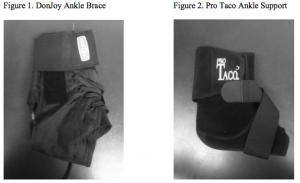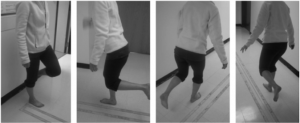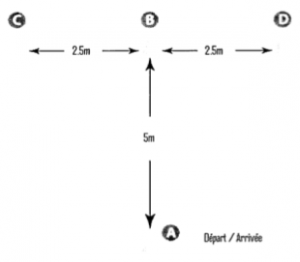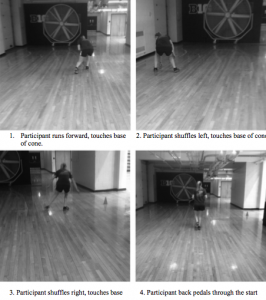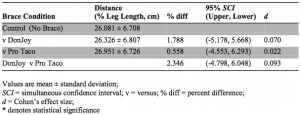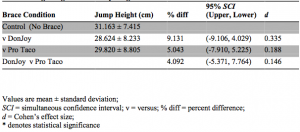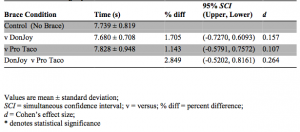Megan E. McFadden, COMPARATIVE STUDY OF DIVERSE ANKLE SUPPORTS AND RELATED EFFECTS ON FUNCTIONAL PERFORMANCE
Title: Comparative Study of Diverse Ankle Supports and Related Effects on Functional Performance
Thesis Supervisor: Dr. W.E. Buckley
Thesis Co-Supervisor: Giampietro L. Vairo
Honors Adviser: Dr. Jinger S. Gottschall
Advice to Future Seniors
A thesis takes a lot of dedication, time, and effort but if you set and meet deadlines and work with your supervisors it will be a successful and rewarding process! Start planning early and pick a topic that you are interested/invested in- you’ll thank yourself for it later. Overall, don’t stress yourself out TOO much over it- if I can do it, anyone can!
Introduction
Volleyball is a sport that requires frequent, explosive and dynamic movements where players must be able to move very quickly in all directions and use quick steps to aid in their reaching maximum vertical heights when they jump. The nature of these movements have contributed to ankle sprains being the most common acute injuries reported in volleyball players. Thus, athletes may opt to wear external ankle supports to stabilize the joint a means to prevent injury. Previous studies have investigated the effects of ankle taping and bracing on joint stability, and while they are suggested to assist in preventing injury, less information is available regarding the effects that influence functional sport performance. Hence, the purpose of this research study is to explore the effects of ankle supports on functional performance in a cohort of healthy and young competitive collegiate volleyball athletes.
Specifically, this experiment focused on profiling responses focal to the crossover hop for distance, single leg vertical jump for height and the modified agility t-test under different braced conditions.
Hypothesis
It was hypothesized that wearing an ankle support while completing the crossover hop test would have little to no effect on performance. Additionally, It was hypothesized that wearing an ankle support while performing a test to measure single leg vertical jump height would have a slightly negative effect on participant performance, manifested in a decreased jump height. It was also hypothesized that wearing an ankle support while running the modified agility t-test would result in a decrease in performance, which will be shown by a slower time for completion of the test. It was hypothesized that, regardless of functional performance measure, the DonJoy brace would have more significant negative effects on performance than the Pro Taco support.
Ankle Supports
The two ankle supports used in this study were the standard, lace-up DonJoy brace and the newer Pro Taco support. The Pro Taco is marketed as a lightweight functional ankle support with compressive structures focal to the peroneal tendons, which is proposed to facilitate proprioceptive activity of the ankle evertors lending to joint stability. This marks a clear difference when compared to bulkier traditional ankle braces (like the DonJoy) that function to stabilize the joint through rigid external supports that restrain inversion.
Participants
Participants in this study were comprised of 18 (9 male, 9 female) young and healthy university students from Penn State that participated in competitive collegiate volleyball at the club level. Each participant served as their own control. Each participant was randomly assigned one of the three conditions at each lab visit: control (no bracing), DonJoy (DJO Global, Vista, CA) ankle brace, or Pro Taco (Topical Gear, Lakeway, TX) ankle support. It was predetermined that the ankle support would only be used on the dominant leg which was described as the leg used to kick a soccer ball for distance and accuracy.
Functional Performance Tests
Crossover Hop For Distance
The goal of the crossover hop is for the participants to cover as much distance as possible with three hops. With each hop, the participant must cross over a pre-marked course that is 20 cm wide by 900 cm long. The participant was instructed to stand on their dominant leg with the lateral portion of the foot in line with the contralateral edge of the course, with the most tip of their longest toe touching the edge of the starting line. The participant was then instructed to try to cover the most distance possible by completing three consecutive hops, crossing over the course with each hop. This measure was normalized to dominant leg length, and the average of three test trials was calculated and used as the final measurement.
Single Leg Vertical Jump For Height
We measured the single leg vertical jump using the Sargent Chalk Jump method. Participants were instructed to stand against a wall with their heels on the ground, and extend their arm on the same side as the dominant leg up the wall as far as possible. They then marked their reach height (the highest point the middle fingertip reached on the wall) with a piece of chalk. The participants were then instructed to stand only on their dominant leg and jump as high possible using a self-selected countermovement without allowing their other foot to touch the ground. The peak height jump, defined as the highest point reached by the participant’s middle fingertip after jumping, was marked on the wall with chalk as well. The distance between the standing reach height and peak jump height was be measured in centimeters and served as the single leg vertical jump height. The mean of three test trials was calculated and used as the participants’ single leg vertical jump height.
Modified Agility T-Test
The modified agility t-test requires a course of four cones. Two cones were placed five meters apart from one another (cones A and B). Two more cones (C and D) were be placed on either side of the far cone (B) at a distance of two and a half meters, forming a course that looks like the letter “T”. Participants started with both feet behind cone A. They then sprinted forward to cone B and touched the base of the cone with their right hand. Next, participants shuffled to their left to cone C and touched the base with their left hand. Participants then shuffled to their right to cone D and touched the base with their right hand. They then shuffled back to their left to cone B and touched its base. After touching the base of cone B, participants remained facing forward and back pedaled to cone A, the original start of the course. The goal of this test was to complete the entire testing course in the shortest amount of time possible. The average time of two test trials was calculated and used for their test time.
Results
No statistically significant results were found with the crossover hop for distance (P=0.924), single leg vertical jump height (P=0.650), or modified agility t-test (P=0.866) across bracing conditions. Thus, this research suggests that the Don Joy and brace and Pro Taco ankle support do not have any significant effects on functional performance.
Conclusions
The results of this study show that the DonJoy brace and Pro Taco ankle support had no significant effects on participant performance on the crossover hop for distance when compared to one another and a control. This outcome supports the null hypothesis. Based on this and prior related data we could potentially infer that wearing ankle supports does not have any negative effects on jumping performance, which is an essential volleyball skill.
Contrary to the second stated hypothesis for this experiment, the data revealed that the bracing conditions did not affect outcome measures on single-leg vertical jump height and time on the modified t-test for agility. Hence, we conclude that the external ankle supports used in this study do not hinder single-leg vertical jump height compared to no brace or when compared to one another.
No significant differences were also found between ankle support conditions with performance on the modified agility t-test. Based on the current study’s results and related literature, it can be assumed agility performance will not be affected by wearing external ankle supports. This finding is important for coaches and athletes because it implies that making rapid movements forward, backward, and laterally, which mimic quick changes in direction will not be hindered or improved by wearing external ankle supports.
From a clinical standpoint, the results of this study are beneficial to athletes who choose to wear these specific ankle braces. This research has shown that the external ankle supports have no significant effects on functional performance measures. This implies that athletes can choose their ankle support based on personal preference and comfort level without experiencing negative effects on performance. Subsequently, it appears as if neither brace offers any benefit to improving functional performance as well. This information may also be useful to strength and conditioning coaches as well as athletic trainers who can use these results to prescribe ankle braces to their athletes based on support and function without seeing decreases in athletic performance.
Acknowledgements
I want to sincerely thank everyone who has made this research possible. I would like to thank my co-thesis supervisor, John Vairo, who patiently and energetically guided me through the entire research experience. Thank you for all of your help and dedication to ensure the success of this study. To my thesis supervisor, Dr. Buckley, thank you so much for all of your feedback, support, and guidance throughout the research process. I would also like to thank everyone who helped me to complete this research including my honors adviser, Dr. Gottschall, and my lab partner, Mark Capuzzi. I would also like to express my deepest gratitude to the members of the Penn State men’s and women’s club volleyball teams who volunteered their time to participate in this study.

